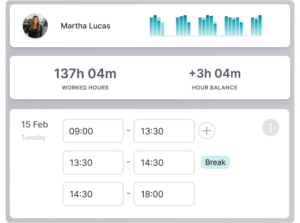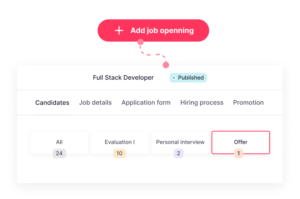March Madness, a well-known yearly basketball tournament in the United States, is currently taking place. All around the country, millions of people are tuning in to watch the NCAA Tournament. Not only that, but the average employee will spend six hours watching March Madness at work. Many are also taking part in March Madness work-themed activities at some point during the month-long event.
But what impact is this having on companies? How should you manage March Madness at work? And what benefits can the tournament offer your organization?
In today’s post, we are going to discuss the parallels between basketball and business, including teambuilding, leadership, and talent management. We will also share some of the issues that HR and managers might face during the tournament, especially those related to absenteeism, scheduling, and potential loss of productivity. Finally, we will explain how Factorial’s tools can help you tackle these issues and build a team of champions.
What does March Madness have to do with business?
The NCAA Division I men’s basketball tournament, commonly referred to as March Madness, is a single-elimination tournament played each spring in the United States. During the tournament, 68 college basketball teams from around the country compete in seven rounds for the national championship. The tournament generates a great deal of excitement and an estimated 70 million Americans complete brackets in an attempt to predict the winning team.
So, what does all this sporting madness have to do with business?
For one thing, whether you like it or not, your employees are likely to spend at least a portion of their days monitoring the games and checking their brackets. You can either get frustrated by the constant fight to remove basketball-related distractions from the working environment, or you can embrace March Madness at work and use it to your advantage.
In fact, there are many parallels between basketball and business that can help you build a stronger and more cohesive team. Many of the strategies used by successful basketball teams can also help you with teambuilding and leadership initiatives in your organization. And many of the tactics used by spectators when they complete their brackets can also be applied to your talent acquisition strategies.
Let’s explore these parallels.
Teambuilding and March Madness
Instead of discouraging March Madness at work, use it as an opportunity to improve employee morale and encourage teambuilding. Creating a fun and interactive activity to celebrate the event in your organization can help bring your team together and develop deeper relationships between colleagues.
For example, you could create your own bracket challenge and invite employees to predict who they think will win the tournament. Make sure you check gambling laws in your area first though as sports betting isn’t permitted in all states. You also need to be mindful of the Interstate Wire Act of 1961 which regulates the transmission of bets and wagers across state lines. Alternatively, you can keep things simple and offer non-monetary rewards such as gift cards, an extra day of PTO, or new office equipment.
You could also relax your dress code during March Madness and allow your employees to wear their team jerseys to support their teams. Or you could even encourage your teams to decorate their departments in honor of their favorite teams and award prizes to the best-decorated office spaces.
Finally, another great idea for March Madness at work teambuilding is hosting a virtual happy hour to celebrate tournament wins. This can be a great way to get your remote workers involved and help them bond with their colleagues.
Leadership and March Madness
March Madness at work strategies can help you develop your workplace culture in a positive way, especially in terms of leadership.
For example, leadership goes hand in hand with trust. The more employees trust their leaders, the more they buy into the decisions they make. But leaders also need to trust their teams. Otherwise, whether in business or on the basketball court, this can lead to ball hogging. In other words, not passing the ball to open teammates so that they can score. Or in the case of business leadership, not trusting your employees, micromanaging, and failing to maximize the skills and potential of every member of the department.
Basketball teams can’t succeed with ball hoggers, and neither can businesses.
Use March Madness at work as an opportunity to review the leadership styles used by your managers. Look out for any bottlenecks that might stifle autonomy and creativity in your teams.
Talent management and March Madness
Finally, another effective application of March Madness at work relates to your talent acquisition strategy.
In many ways, completing a tournament bracket is a lot like your recruitment and selection process. You have to balance your options and research team records and histories. You then have to create a shortlist based on opinions, reviews, and recommendations. Plus, you have to consider potential when you make your final decision, as well as teamwork; past performance isn’t the only indicator of future success.
Recruitment works in exactly the same way.
Have you included all these considerations in your recruitment funnel? Does your talent acquisition process evaluate teamwork and take into account a candidate’s potential for development? Are you offering an optimal candidate experience?
Moreover, celebrating March Madness can give employees the chance to rest and recharge with fun activities. This in turn can boost employee morale, satisfaction, engagement and productivity. And the happier and more motivated your workforce is, the lower your turnover rate will be. In other words, March Madness can help you enhance your employee experience so that you can boost your retention levels as well as your talent acquisition strategies.
Potential March Madness issues in the workplace
Perhaps the biggest issues you might face during March Madness at work relate to absenteeism, last-minute scheduling changes, and issues with productivity.
For example, you might find that employees are easily distracted by the tournament and constantly check their brackets to see if they have won. In fact, some studies suggest that March Madness could cost employers nearly $4 billion in lost revenue. Other sources, however, believe that the drop in office productivity around March Madness may be overstated. Either way, most employers find that absence rates increase sharply during March Madness, leading to scheduling and staffing issues.
However, the benefits you can gain by embracing March Madness at work far outweigh the risks. After all, building a culture of autonomy and trust is vital in the modern workplace, so implementing a zero-tolerance approach to March Madness is only going to damage your business in the long term. It all comes down to balance.
The key is being clear about your expectations and defining clear guidelines for requesting and tracking time off. Employees should feel they have a right to celebrate March Madness. But they also need to respect your expectations in terms of performance and productivity. Provided you implement the right controls and use the right tools to manage absenteeism, last-minute scheduling changes, and productivity then there is no reason why your team cannot celebrate the tournament whilst maintaining performance levels at all times.
Tools to champion your team
As we just highlighted, the best way to address the issues associated with celebrating March Madness at work is by using the right tools and technology.
Factorial’s HRIS includes a number of features that can help you with this, especially in terms of time tracking, scheduling, and talent acquisition. That way, you can encourage your workforce to celebrate the event whilst using the strategies discussed today to build a team of champions.
Let’s take a look at these features in a bit more detail.
Provide time off
Factorial’s time off management software can help you manage and track absences during March Madness.
For example, you can create your time-off policy directly on the platform so that your staff has access to it at all times. That way, your employees know exactly what they need to do when they want to request vacation leave. You can also include specific guidelines relating to time off during March Madness. Employees can then request time off through the employee portal, and these requests get sent directly to the right managers for approval.
You can also create blocked periods so that employees cannot request days off during busy times, reducing the time you need to spend rejecting requests that you cannot accommodate. Plus, by centralizing your time-off process through Factorial’s platform, you can keep updated on team availability at all times.
Here are a few other benefits of using Factorial’s time-off management software during March Madness:
- Automate vacation requests.
- See vacation days accrued, used, and remaining.
- Use the calendar to review upcoming employee absences with ease.
- View all upcoming sick leave, vacation days, and other types of leave at a glance.
- Track vacations to make sure each team is adequately staffed.
- Set permissions to determine which supervisors will need to approve absence requests.
- Generate custom reports.
All this makes it much easier to handle your March Madness at work time off requests efficiently.
Provide flexible scheduling
Factorial’s shift management software can help you better manage your employee schedules during March Madness at work. That way, you can be sure that your teams aren’t left understaffed due to uncoordinated absences.
For example, you can use our free downloadable employee shift schedule template to organize your staff’s daily shifts. Employees can then use it as a reference and comment on any upcoming schedule conflicts. Plus, you can customize the template for defined periods, so you can create a specific schedule to cover the tournament period.
There are a lot of other benefits of using our shift management software:
- Assign shifts to employees based on current and upcoming availability.
- Gain better planning visibility with a complete overview of who is working and when.
- Automatically detect scheduling gaps and conflicts so that you can address them.
- Update your team as and when schedules and availability change.
- Receive notifications of newly published or modified staff shifts.
- Customize the way you view your employee shift schedules to optimize planning.
- View hourly absences on the shift schedule to gain insight into employee availability.
- Integrate the solution with your time off software.
- Run reports to help you spot trends and better understand your scheduling needs.
Scout out the right talent
Finally, Factorial’s talent acquisition software and applicant tracking system can help you optimize your recruitment funnel and candidate experience. This helps you enhance your end-to-end hiring process and create a larger quality talent pool.
For example, with Factorial’s ATS you can create personalized job offers, application forms, and pipeline workflows. You can also design your own customized hiring page to showcase your company, team, and available positions. This will help you attract more candidates and improve your overall recruiting process.
Best of all, you can use all the data you collect to effortlessly integrate new employees into your onboarding software once you’ve hired them. That way, your entire candidate lifecycle is centralized, and you can focus on attracting and retaining top talent. In other words, you can redirect your efforts to building your own team of champions.
Happy March Madness at work month, everyone!






